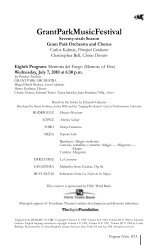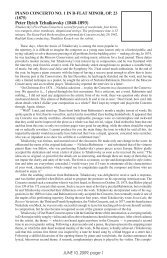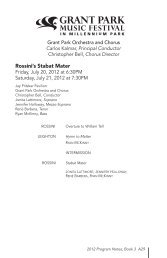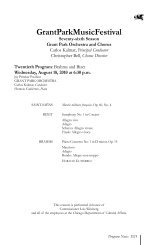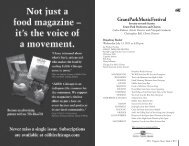The Four Seasons of Buenos Aires - The Grant Park Music Festival
The Four Seasons of Buenos Aires - The Grant Park Music Festival
The Four Seasons of Buenos Aires - The Grant Park Music Festival
Create successful ePaper yourself
Turn your PDF publications into a flip-book with our unique Google optimized e-Paper software.
Friday, August 3 and Saturday, August 4, 2012<br />
range, from violent to sensual, from witty to melancholy, from intimate to theatrical.<br />
Among his most ambitious concert works is Las Quatro Estaciones Porteñas (“<strong>The</strong><br />
<strong>Four</strong> <strong>Seasons</strong>”), published originally for piano solo in 1968 and later arranged for his<br />
own ensemble (he <strong>of</strong>ten used one <strong>of</strong> the movements to open his concerts) and for<br />
strings and piano. <strong>The</strong> four movements, beginning with Spring, are not specifically<br />
pictorial, as are Vivaldi’s well-known precedents, but are instead general evocations <strong>of</strong><br />
the changing seasons in Piazzolla’s native Argentina.<br />
<strong>The</strong> Three-Cornered Hat (1917, 1919)<br />
Manuel de Falla (1876-1946)<br />
<strong>The</strong> Three-Cornered Hat is scored for pairs <strong>of</strong> woodwinds plus<br />
piccolo and English horn, three horns, three trumpets, three<br />
trombones, tuba, timpani, percussion, harp, piano, celesta and<br />
strings. <strong>The</strong> performance time is 30 minutes. <strong>The</strong> <strong>Grant</strong> <strong>Park</strong><br />
Orchestra first performed selections from the ballet on July 9,<br />
1948, with Alfredo Antonini conducting.<br />
<strong>The</strong> dazzling Parisian success <strong>of</strong> Sergei Diaghilev’s Ballet Russe that began in 1909<br />
came to an abrupt halt when the Guns <strong>of</strong> August tore across Belgium and France to<br />
begin World War I in 1914. Diaghilev, Leonide Massine and some <strong>of</strong> the company took<br />
refuge in Switzerland and Spain, while Nijinsky and others fled to America. Diaghilev<br />
arranged a season in Spain for 1917, and, always on the prowl for new talent, he took<br />
the opportunity to look up a musician Stravinsky had met in Paris in 1910. Stravinsky<br />
described his Spanish colleague as “even smaller than myself, and as modest and<br />
withdrawn as an oyster... unpityingly religious, and the shyest man I have ever met.”<br />
His name was Manuel de Falla.<br />
Falla, a meticulous worker who composed slowly, had completed only a small<br />
number <strong>of</strong> works by 1917 — most notably Nights in the Gardens <strong>of</strong> Spain, the opera<br />
La Vida Breve (“<strong>The</strong> Brief Life”) and the ballet El Amor Brujo (“Lover, the Magician”) —<br />
and he was little known outside his homeland. When Diaghilev and Massine introduced<br />
themselves to him in Barcelona, he took them to see a one-act farce set in the early<br />
19th century about the attempted seduction <strong>of</strong> a miller’s wife by the local governor<br />
for which he had provided the music, El corregidor y la molinera (“<strong>The</strong> Corregidor and<br />
the Miller’s Wife”). <strong>The</strong> script for this “pantomime” was by Gregorio Martinez Sierra,<br />
who based it on a short novel by Pedro de Alarcon published in 1874 as El sombrero<br />
de tres picos. Alarcon was said to have heard the story in turn from an old goatherd<br />
who hired himself out as an entertainer for local weddings and feasts. Of Falla’s score,<br />
Massine wrote that it “seemed to us very exciting, and its blend <strong>of</strong> violence and<br />
passion was similar to much <strong>of</strong> the music <strong>of</strong> the local folk-dances. Both Diaghilev and I<br />
felt that the story and the music <strong>of</strong>fered us the potentials <strong>of</strong> a full-length ballet.” Falla<br />
accepted Diaghilev’s proposal to revise and extend his score for production when the<br />
war was over, but gave the provision that he be allowed enough time to study Spanish<br />
folk music and dance styles to assure the correct atmosphere for the finished work. It<br />
was not until World War I ended that the production <strong>of</strong> <strong>The</strong> Three-Cornered Hat could<br />
be staged as part <strong>of</strong> the 1919 London season <strong>of</strong> the Ballet Russe.<br />
<strong>The</strong> racy story <strong>of</strong> the ballet has its roots in the folk traditions <strong>of</strong> Spain. <strong>The</strong> curtain<br />
rises on the sunny esplanade beside a mill. <strong>The</strong> miller and his pretty wife are busy<br />
about their chores. A stately procession enters carrying the elderly Corregidor (the<br />
local magistrate) and his wife. <strong>The</strong> Corregidor is attracted to the miller’s wife, and slips<br />
back after his retinue has left to make his advances. <strong>The</strong> wife tells her husband to hide<br />
and watch her spurn the old man’s attempts at love. She dances a brilliant fandango<br />
and further tantalizes him with a bunch <strong>of</strong> grapes. He chases her, trips, and becomes<br />
2012 Program Notes, Book 4 A31



